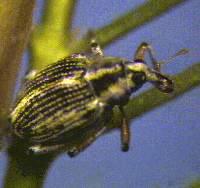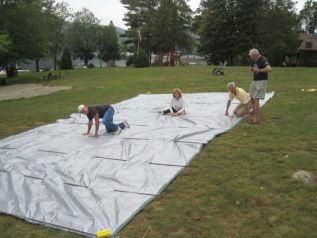Controlling Eurasian Milfoil
While it is thought that it is impossible to completely eradicate milfoil once it has been established in a body of water, there fortunately are measures for keeping it under control. Unfortunately, these measures are either expensive, illegal, or unadvisable.
Here is a summary of the various methods. A detailed description of each method follows.
| Method | Advantages | Disadvantages |
|---|---|---|
| Milfoil Weevil | Relatively inexpensive, less intrusive | Effectiveness is unpredictable |
| Herbicides | Effective | Generally illegal in Adirondack Park, expensive, temporary |
| Bottom Matting | Effective | Use limited to small areas, eliminates all vegetation |
| Hand Harvesting | Effective | Expensive |
Milfoil Control Techniques
Not Appropriate for Brant Lake

Milfoil Weevil
Use of this small aquatic weevil is very appealing, since it is native to the US and prefers dining on Eurasian Milfoil over other vegetation. There appears to be some spotty success stories with using this insect, and there is a company, EnviroScience, that specializes in treatment using this weevil. Unfortunately, there is currently no understanding of why it has shown to be effective in some lakes but not others. As academics like to say, "More studies are needed". We are monitoring the developments in using this technique. More information on weevils can be found here.
Herbicide Control
There are herbicides, such as Sonar and its more modern cousin Renovate OTF, that can be used to control milfoil. However, the chemicals are very expensive, and often need to be repeated every few years, as has been the experience at nearby Glen Lake. More significantly, while use of herbicides to control milfoil within the Adirondack Park were for the first time approved in 2010 for use in Lake Luzerne, it was a very carefully controlled experiment under relatively ideal conditions. Those conditions would be impossible to replicate on Brant Lake, and thus approval for use on our lake is currently extremely improbable. Scratch herbicides.
Milfoil Control Activities on Brant Lake
Our activities fall into five areas:
Public Education
- Milfoil related presentations are regularly given at the two annual BLA meetings, which are open to the public.
- A well-publicized community-wide milfoil informational meeting was held in 2008.
- A Brant Lake Milfoil Control web site was established in 2009 for public education and volunteer coordination.
- An informational bulletin board was placed at the public boat launch in 2009.
- A Milfoil Control Program brochure was developed In 2009. It was delivered to lake residents door-to-door and placed in 34 commercial establishments in the greater Brant Lake community.
- "Clean Boats, Clean Waters" bumper stickers were developed and distributed in 2009.
- Informational mailing on milfoil control activites sent to association members in 2009.
- An Aquatic Plant Invasive Identification Training session held at the Town Hall in 2010
Fund Raising
In 2009 a major three year fundraising campaign was initiated.
- A community-wide kick-off meeting was held at the Town Hall.
- Over 30 volunteers conducted a lake residents door-to-door campaign to distribute information about the campaign.
- Area businesses and significant donors were personally solicited by the Finance Committee.
- A mailing was sent to all BLA members.
- Generous donations were made by many area businesses, including: Able Energy, Gallo Realty, Smith's Plumbing, Adirondack General Store, Glens Falls National Bank, Stewarts, Brant Lake Camp, North Country Auto Repair, Sunset Mountain Lodge, Brant Lake Taxi, Palmer Bros. Marina, Buchanan & Butler, and Paraco Gas Co.
- A Milfoil Fund Raising Phonathon was conducted.
- With donations and pledges the $250,000 three year goal was met!!!
Significant financial support has also come from the Town of Horicon, which has contributed:
- 2012 - $20,000
- 2011 - $40,000
- 2010 - $40,000
- 2007 - $5,000
There is also an on-going effort in grant applications and donations from local businesses. Successes to date are:
- In 2011 the following local businesses made significant contributions: Stewart's Shops - $500, Jacob & Toney - $100, Gallo Realty - $125, Chestertown Grand Union - $100, Glens Falls National Bank - $500, Price Chopper - $250, International Paper - $1,300.
- $500 from Dake Foundation (Stewart's) in 2009
- $10,900 Invasive Species Grant in 2005.
Record Keeping
A key to fighting milfoil is to have in-depth knowledge of each bed in the lake. Numerous activities at our lake have contributed toward satisfying this need.
- All information is logged into a milfoil spreadsheet. This is a significant, ongoing effort. Information tracked is:
- Bed location, determined by GPS
- Yearly history of the bed
- Number of mats (if any)
- Date last inspected
- Next action to be taken
- The spreadsheet information is uploaded to the milfoil control website and is available for viewing in a variety of forms:
- Raw data
- Map showing location of beds. Clicking on a bed location displays the detailed information for that bed.
- Map showing location and number of bottom mats in place.
- A dedicated hot-line telephone number is available to report a milfoil bed discovery. All reported beds are investigated and added to our spreadsheet if they are new. Numerous new beds have been reported using either this number or email.
As of 2009 32 milfoil beds have been documented.
2010 Update: The company we hire for milfoil control, AIM, added the facility for divers to communicate with surface personell, allowing them to dynamically map locations where milfoil was found and removed. Additionally, as of the end of 2010 all known infected areas were milfoil free. Thus we are no longer maintaining a map of milfoil locations. However, the data and map of unremoved bottom mat locations is still in use.
Bottom Matting

Lake bottom mats, also know as benthic barriers, are fabric materials that are placed on sections of the lake bottom by divers and held in place with weights. They are legal for use within the Adirondack Park. This is a labor intensive but effective method for controlling milfoil. Benthic mats are particularly useful in treating small to moderate sized patches of dense growth. The barriers are used to reduce light levels and inhibit growth of vegetation. While matting kills all plant species indiscriminately, in colonies where matting is used milfoil has typically already crowded out the other species.
This operation requires mats and divers to place them. Fortunately, using volunteers we have been able successfully implement this technique at minimum costs.
While there are commercially available mats intended for this purpose, they are very expensive. We have devised a simple and cost effective technique for using volunteers to build these mats using heavy duty tarps and rebar (steel rods). The tarps are unfolded, holes are strategically punched, and the rebar is woven though the mats. The rebar is then tied at the edges with nylon tape or cable ties. The rebar serves as weights to hold the mat to the bottom, and the holes also serve as vents to allow gas to escape as the covered vegetation decays.
In 2009, 34 20′x35′ mats were constructed. This is approximately a half-acre of material! All 34 of the mats were placed on the bottom by our volunteer teams.
Our divers place the mats on the lake bottom directed by GPS coordinates in our milfoil bed database. This is typically a difficult job, since the mats are heavy, there are numerous obstacles of rocks and stumps on the bottom, and the divers frequently have to work by feel because of stirred up sediment. Volunteer surface workers must also be used to collect any milfoil fragments that result from the activity. All operations must be carefully entered into the milfoil database so that the mats can later be located and removed after they have done their job. They may then be re-used in another location if their condition permits.
In 2011 the mats have done their job, and with milfoil now under control in the lake there is a major undertaking to remove the mats to allow native vegetation to return.
Hand Harvesting
Hand harvesting of milfoil is also allowed in the Adirondack Park. It is similar to weeding in a garden, with the difference that you are working underwater with very limited visibility due to stirred up sediment. Divers uproot individual plants and either put them in a mesh bag or use a suction tube to transport them into a boat. Special care must be taken to ensure that the entire plant (leaves, stems and roots) is removed. This is an extremely labor-intensive operation, and at Brant Lake our volunteers diver are only able to handle a small portion of the work that has needed to be done. This requires us to hire professionals to do the bulk of the work, at considerable expense. Our expenses to date are (roughly):
- 2009 - $100,000
- 2010 - $85,000
- 2011 - $50,000
- 2012 - $35,000 (projected)
Volunteer Hand Harvesting

When milfoil was easy to find in the lake we used a pool of 10 volunteer diversto do a limited ammount of hand harvesting, As is 2009 this activity has been discontinued.
Professional Hand Harvesting

Aquatic Invasive Management (AIM) was formed by Andrew Lewis and Tommy Thomson, alumni of the Paul Smith’sCollege of Natural Resources. The BLA first contracted with AIM in the fall of 2008. Prior to selecting AIM, members of the Milfoil Committee searched the internet, consulted with the Adirondack Park Council, and networked with milfoil committees from Loon Lake, Schroon Lake, and Saranac Lake. The committee in Saranac Lake was the most experienced at milfoil control, and several years ago they chose AIM to assist them with their efforts. The AIM organization has extensive experience and they have made tremendous strides toward controlling milfoil in Saranac Lake. In addition, they have done milfoil removal on Minerva Lake and Lake George.

AIM has developed two approaches to milfoil removal. In low density areas an 8-diver team operates in a line formation over a wide geographic area to remove scattered plants and small beds. This approach has the support of a 2-person crew and is able to cover large areas efficiently. For high density areas a 10-member crew utilizes eight divers inside a series of nets erected around the harvest site. This allows for plants to be pulled out at their roots, but rather than bagged individually, plants float to the surface within the netted area and are transferred into boats for transport to shore by the above water team. These techniques have allowed AIM to maximize the effectiveness of hand harvesting for both high and low intensity sites. Additionally, these techniques allow the divers to breath using individual air lines supplied by a single compressor on a floating platform, which is much more efficient than requiring each diver to use individual air tanks.
In 2009 AIM added the capability of communication between the divers and the surface crew, allowing them to created detailed maps of where milfoil was found and removed.